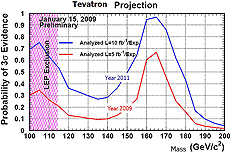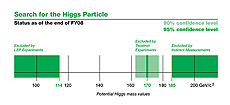AAAS coverage
Editor's note: Symmetry magazine staff wrote a series of blog posts from the AAAS meeting. The following articles are a sample of the posts available on the symmetrybreaking Web site.
Hunt for the Higgs kicking into high gear

If the Tevatron experiments collect data through 2011, their chance of finding evidence for the Higgs particle is larger than 30 percent for most of the Higgs mass region of interest, 114 to 185 GeV/c2. A Higgs mass of 170 GeV/c2 already is excluded by the analysis of Tevatron data last summer (see plot below).
Researchers with the Tevatron experiments at Fermilab told fellow scientists and journalists not to count them out of the race to discover the Higgs boson.
“In the next few years, if the Higgs lives in the expected mass range of 114 to 185 GeV, we will most probably see evidence of its existence,” said Dmitri Denisov, co-spokesman of DZero and a Fermilab staff scientist, Sunday at the American Association for the Advancement of Science conference in Chicago.
The Higgs explains how particles acquire mass, and is the last, missing piece of the Standard Model, which explains matter and how it acts. Essentially, the Higgs is the last piece of a puzzle describing everything around the world, including ourselves, Denisov said.
While the Large Hadron Collider in Europe is the new, bigger kid on the high-energy physics’ block, Tevatron researchers said their smaller experiments bring a finely-tuned machine and a head start to the game.
It might take the LHC until 2011 or 2012 to reach the sensitivity needed to find the Higgs, said Jim Virdee, spokesman of CMS and a professor at Imperial College of London.
Read more
-- Tona Kunz

Higgs mass exclusion plot as of summer 2008.
A first: String theory predicts an experimental result
The biggest criticism of string theory is that it doesn't make predictions that can be tested experimentally-a requirement for any solid scientific idea.
That's not true anymore.
At an AAAS session on Sunday, physicists said string theory is making important contributions to the study of two extreme forms of matter -one heated to trillions of degrees, the other chilled to near-absolute zero. In both cases the matter became a "perfect liquid" that ripples and flows freely, like water. String theorists analyzed the results by applying what they had learned from pondering how a black hole might behave in five dimensions. Then they went on to calculate just how free-flowing these liquids might be, predictions that the experimenters are using to guide the next stage of their work.
"It's really a surprising, I would say serendipitous, once-in-a-generation convergence of scientific communities," says Peter Steinberg, a nuclear physicist at Brookhaven National Laboratory and one of the organizers of the panel. "None of us saw this coming."
Read more
--Glennda Chui
|